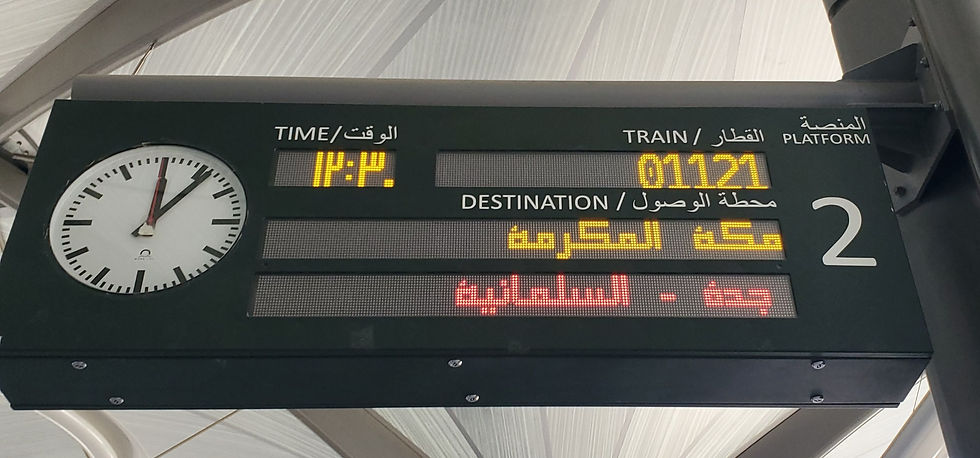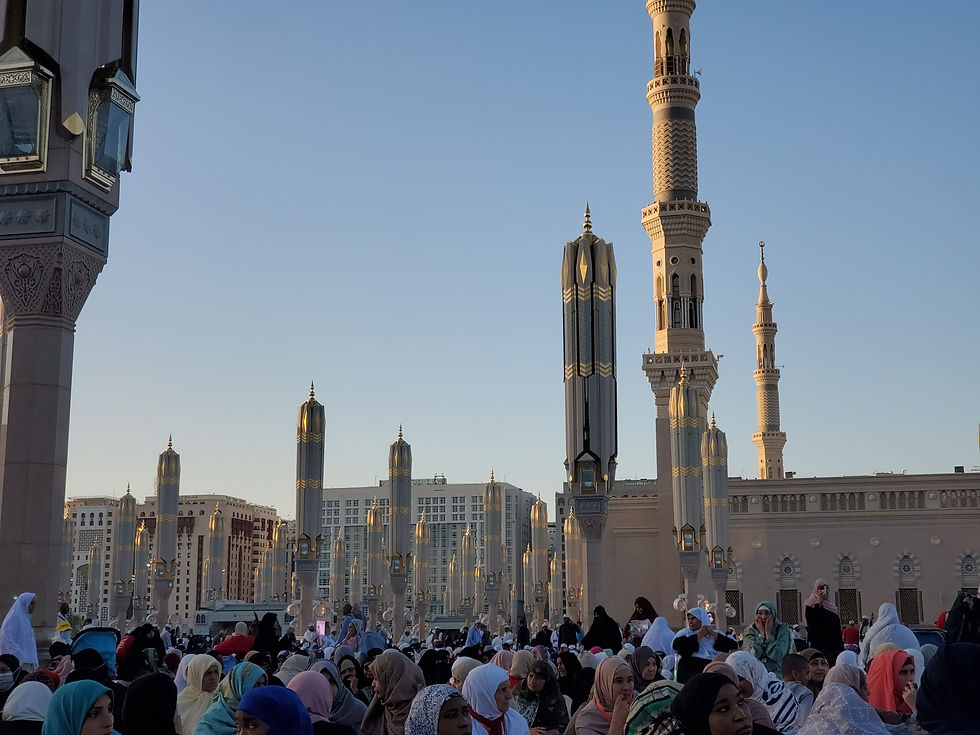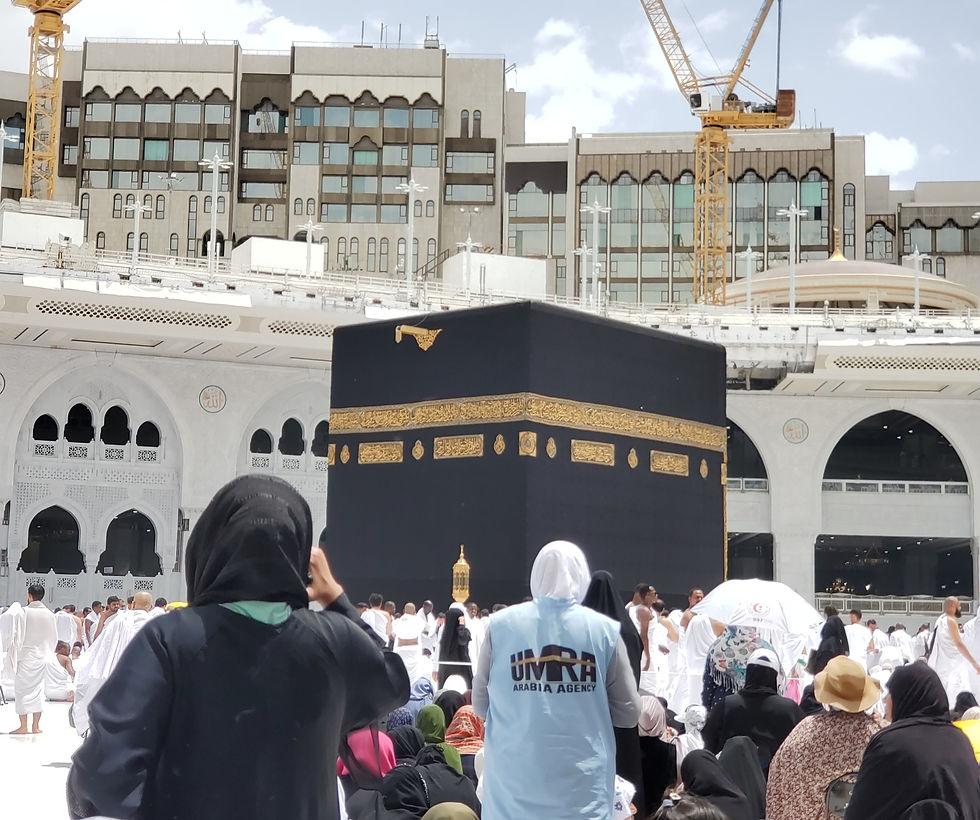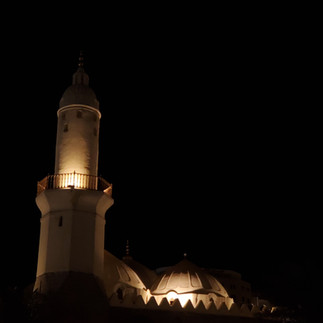EVERYTHING YOU NEED TO KNOW ABOUT UMRAH IN THE BLESSED MONTH OF RAMADAN
- ieattravelwrite
- Apr 30, 2024
- 13 min read
Updated: Jun 19

Once you have experienced Umrah in Ramadan, there is no going back. Visiting the Holy Land at any other time of the year will feel different. It almost feels as if there is a missing puzzle piece. As much as I hate big crowds, performing Umrah in Ramadan was one of the best experiences I ever had, despite the journey not being easy.
To help you plan your trip, you can find some of my best tips below, along with ways to maximize your time in the blessed month. I can confidently say that the Ramadan experience is unmatched for several reasons and after going through this post, I am sure you will agree with me on this. In this guide, you can find everything I learned from my past experiences (Alhamdulilah, I have been there in Ramadan twice before). This post is a little long, but it covers essential tips that other websites won't tell you.
1. ADVANCED PLANNING

If you know me, then you know that advanced planning and I don't go well together. I prefer to book everything last minute and to be spontaneous with my travel plans, however, going for Umrah in Ramadan is the one exception. Planning well in advance is extremely important as it is the key to save money. A lot of tour groups may book up slots at the hotels, especially the ones near the Haram. There are many hotels that are within walking distance, but not necessarily inside the Clock Tower, that you can opt in for.
Others nearby may also offer a free shuttle, however do note that it is quite a walk from the masjid to the shuttle station. Last year, with the crowd alone, it took be about 25 minutes to walk to the shuttle stop. Once there, it was a struggle and a test of patience navigating over 100 shuttles in one place to find the right one. Some hotels are more organized and have a big sign, but for some of the buses, you have to read the small paper printed and taped to the window. Sometimes, they park in different areas of the lot, so you need to walk around a lot to find the right one. Some days, I preferred to take a taxi just because of how difficult it was to find my shuttle. I also found the walk to the stop exhausting in the heat.

Personally, I prefer to be closer to the Haram and at a hotel that is within walking distance (even if it's a 20 minute walk or so), as you don't have to constantly rely on taxis/shuttle and you are free to leave whenever. I also find that many people who are traveling solo will post on Facebook groups asking to share their rooms and split the cost, so even if you may spend a little more to stay closer, it makes it worth it and a little easier for you. By being closer to the masjid, I found that I had more energy and was able to focus better.
If you are staying for an extended period of time or you are with a big group, it may be better to find a rental to avoid high hotel rates. This would mean you get access to laundry and a kitchen as well. If you are at a hotel and need to do laundry, but want to avoid paying high fees from the hotel, you will find people outside offering the services. They may charge by kilo and will have it delivered to you either the same day and/or the next.

I recommend booking train tickets between cities in advance, as they need to fill up and it may be harder to find closer to your date. However, if you are a big group or more than 3-4 people, it may be more cost effective to take a taxi. There is a strict luggage policy on the train and you are allowed to only bring limited pieces with you. If you bring more than your allowance, then you'll just have to pay and come back to the station to pick it up later.
2. DIY OR TOUR PACKAGE?
The question is, do you choose a tour package that has everything arranged for you or do you do everything yourself? Every time I have been to Umrah so far (even outside of Ramadan), I have DIY'ed my way, only because it was more cost effective for me.

While the packages offer more ease and peace of mind, they can be quite costly. I have seen packages go for as much as $4,000 CAD per person (some may include flights, but the cost can quickly add up, especially if you are a big group. It may be worthwhile if you are a solo traveler, but ensure to do a rough estimate of your costs to get a better idea).
By simply planning in advance and doing some research prior to my trip, these costs can be significantly reduced. I also realized that after my first trip to Umrah, I didn't really plan on visiting all the sites again on my other trips (though you can easily hire a taxi driver to take you there if you want). I suggest you research well and check your options depending on your budget, as you may find something that works for you. Just because the travel agencies hasn't been the case for me, doesn't mean it is the same for you!

Booking a package may also mean having someone else figure out any details regarding your visa. However, if you decide to do-it-yourself, remember to check for any visa requirements and/or other documentation you may need. When choosing my visa (which I applied for online instead of getting it on arrival), I opted for the tourist visa over an Umrah visa, as it is valid for a year and gives me more flexibility to go elsewhere in the country. However, if you are only planning to come to Saudi Arabia for Umrah, you may want to get an Umrah visa, as it has its benefits too. It all depends on what works best for you.
3. DO YOUR HOMEWORK
A lot of people wait until they get to Makkah to learn how to perform Umrah. It is best to prepare yourself before your arrival, as the spiritual journey can take a toll on you emotionally, physically and emotionally. Remember going for Umrah is NOT a vacation. It is a trip that is unlike any other. Preparing yourself is extremely important so that you don't feel too overwhelmed. It is also imperative to learn the steps to Umrah as you need to get into the state of Ihram before reaching Makkah.
Setting your right in the first step you must take in preparation for the trip of your life. Learn about the significance of the pilgrimage. Download an Umrah app (there are many now), have the steps handy (you can even print them out) or get a book to guide you. It would also be helpful to read about the journey and/or watch some videos about what to expect, what to do, etc. This way, you can avoid making mistakes and risk invalidating your Umrah.
One of the best tips that I can suggest is to prepare a Du'a list and to bring it with you. One of the things that fascinate me most about having a Du'a list is going back through the list later on (maybe a year later) and realizing how much may have changed in your life and what you have been granted. It is a great reminder of the power of prayer and makes you appreciate the things you have or may have lost along the way.
4. BEST TIMES OF THE DAY TO PERFORM UMRAH

Is there a better time to perform Umrah to beat the crowd or is it constantly full? Well, it depends on you and where/how you want to perform your Umrah. For me personally, I prefer to go right in front of the Kaaba rather than upstairs. There are areas dedicated for special assistance and you can get a free wheelchair if needed. Going upstairs may also mean being exposed to less sun, which may be a better option for you.
If you have kids, I would recommend staying upstairs, as it may be harder with the kids with the big crowds in front of the Kaaba and believe me, people are always pushing you there, or stepping on your foot, etc. I have also seen people with kids on the main floor, but they either hold them or put them on their shoulder.
Going when the sun is at its peak may mean less people, but it will make it more challenging for you because of the heat. After Taraweeh, I found that it is usually better, especially if it is closer to 11 pm - 2 am. Do note that closer to prayer times, if you are in the middle of performing Tawaf, the guards may ask you to move so that they can start preparing to pray. In this case, it is helpful to have a Tawaf counter with you to remember where you are and how much you have left.
5. HOW TO BEAT THE CROWDS FOR IFTAR AND SUHOOR

One of the best decisions I made in Ramadan was to always order on the delivery apps, rather than going to eat out in person. This way, I can have more time for myself and less time having to wait in long lineups for food. I downloaded an app called MR SOOL (you need to have a local number), where I placed most of my orders for iftar. I tend to order at least 1.5-2 hours before Maghrib or after Taraweeh, so that I don't need to get out of the masjid between Maghrib and Isha. The portions are big enough to last me through Suhoor.
Ordering in was much easier in Madinah than it was in Makkah. I found it to be more convenient to go out for food in Makkah, however, I recommend going to the restaurants to place your order at least 1.5 hours before Maghrib. This means that you will most likely be eating your food cold, but at least you can enjoy it at the Haram and/or beat the crowds! If you walk out to restaurants further out, you will also find food to be cheaper than at the restaurants nearby.

In Madinah, my iftar lasted me through the morning for suhoor. It was helpful that our hotel room had a microwave in Madinah, as we used that to heat up our suhoor. In Makkah, my hotel included suhoor, however, other people I traveled with did not have suhoor in their package, so we would often buy stuff from the night before at Bin Dawood to have in the morning or any leftovers from the Iftar pack.
Did you know that there are also many locals who take orders for food? This means you can have a customized meal plan that is delivered to you and be treated to a homemade meal.
6. BREAKING YOUR FAST AT THE HARAM

If you decide to break your fast at the Haram, you will most likely be given a food pack depending on where you are sitting. The bag typically consists of dates, water, juice, a croissant or cake, and yogurt. The iftar pack is usually enough to get me through Taraweeh. This helps me save my spot and avoid going out in the crowd between prayers. You can bring your own food too to save time. I suggest going to the supermarkets to purchase items, such as fruits, snacks (ie: nuts) and/or prepared foods as the lineups may be shorter than at the restaurants. I like to go to Bin Dawood to get my essentials, and I especially love their ginger shot, which helps boost your immunity!
You will often come across people distributing iftar around the Haram, whether it be others sharing their dates, samosas, bread with you. There are volunteers that come around with Arabic coffee. There are people who sometimes give out meals, such as rice with chicken.
7. FINDING THE BEST SPOTS TO PRAY
The Prophet Muhammad (PBUH) said, “The prayer in my Masjid (Masjid An-Nabawi) is better than one thousand (1000) prayers in any other masjid with the exception of Masjid Al-Haram, and a prayer in Masjid Al-Haram is better than one hundred thousand (100,000) prayers.”

While the feeling of being inside the masjid for prayer is difficult to express, it is not always easy to find a spot. Another place I love going to is the rooftop, because you can sometimes feel a nice breeze.
Ultimately, the best view you can have is to be right in front of the Kaaba if you are in Makkah. One of my best tips to get this view at prayer time is to perform tawaf (do note that they only allow you to go to the main floor if you are performing Umrah, but for women it is easier, since they can't tell). For men, it is more challenging as you need to be in Ihram. On Jummah, I like to go for a tawaf at least 3-4 hours before Jummah, so that I can stay near and pray right there. The guards may start blocking a lot of the areas closer to prayer times, thus by ensuring you come early, you get a better chance at securing a good spot to pray.
8. MAXIMIZING YOUR REWARDS

What does my schedule look like in Ramadan when I'm in Saudi Arabia? As I mentioned, a spiritual journey is very different from a vacation and while you will get time to relax (especially if you are spending time in Madinah), you can expect your sleep schedule to be a little upside down.
Typically I try my best to stay for all raka'ahs of Taraweeh, up till Witr. After Witr, I would then head back to the hotel and take a small nap if possible of at least 1-2 hours, before waking up for Tahajjud and Suhoor. This mean that in a night, I would only be getting 1-2 hours of sleep, if any. Once I get up in the middle of the night, I try my best to stay up past Fajr until the sun has risen. Did you know you can get the reward of performing one Hajj and one Umrah if you pray Fajr in congegration and then you remain there and pray two Rak'ahs after the sun rises? [At-Tirmithi]

Additionally, you can maximize your rewards by praying in congregation, investing a lot of time in reading Qu'ran, worship and istighfaar.
My sleep schedule would then only consist of 4-5 hours, since I would sleep from then until closer to Dhur time. After Dhur time, you can sometimes also have some free time for a quick nap before Asr.
I typically like to go to the masjid from Asr to Fajr, however when my hotel is close enough, I will come back after Asr to avoid using the public washrooms and then go back closer to Maghrib time.
9. THE PEACEFUL CHARM OF MADINAH
Visiting the peaceful city of Madinah is a must in Ramadan! While the moments in Makkah always feels surreal, especially when you hear reciters such as Sudais during prayer (which for me brings a lot of memories from my childhood), Madinah is special and the best place.
Makkah can get quite chaotic, especially with the big crowds. The heat is worse in Makkah as well and I feel that you can experience more road closures, see a lot more traffic (depending on which exit you are at, you may see a lot of taxi drivers going to Madinah or looking to take people to Jeddah, etc). People are different in Makkah compared to Madinah. I had a more positive experience in Madinah, and despite the big crowds in Madinah too, I did not feel it as much. There is a breeze that I felt in Madinah that I have not felt elsewhere. While it was hot in Madinah, it did not feel like it. I felt at peace.
10. TRAVELING WITH KIDS
Now here is one thing a lot of people don't know: there is a center for loss prevention of children! In Madinah, every time we walked by the center, I found it closed unfortunately. I was hoping it would be open, as you can go there to get a wristband with your contact information in case you lose your child. Since I noticed it closed, I would suggest at least having that contact handy on your child in case it happens. It could something as simple as having the information down on a piece of paper, in their pockets.
As hard as it is to travel with kids, especially to the Holy Land, it is not impossible.
Depending on the child's age, it would be beneficial for them to learn about the significance and importance of performing Umrah, as well as history behind the places you visit. There are multiple things to do with kids, especially in Madinah, with kids and it offers a great learning experience for them.
To keep them busy during prayer times, I suggest packing lots of toys and books so they don't get bored. It would be good to allow them to use their energy before Maghrib so that they can feel tired and maybe sleep through the prayer. If the kids are a little older, encouraging them to pray with you is a great opportunity to allow them to make the most of their experience while learning about Islam and its importance in their lives.
11. WHAT TO DO WHEN YOU GET SICK
Did you know that if you are on an Umrah visa, you are allowed to use the free medical centers near the Haram?
Given there are millions of pilgrims, you can expect to have a long lineup at these medical facilities, but there is more than 1 around. I waited over 1.5 hours in Madinah only to find that is only applicable to those on an Umrah visa.
Another option is to take a taxi to a private clinic, where you can get the right care in less than 45 minutes. These private clinics may come with a high price tag, but this is where having travel insurance helps! After consultation and getting the prescriptions needed, the total cost for the one visit alone came to approximately $150 CAD, not including the taxi to/from the clinic.
12. BRINGING ZAMZAM HOME
When you have an Umrah visa, you are allowed to buy 1 liter of Zamzam to bring back with you. Airlines check in the Zamzam box as a separate piece of luggage for free. You are only allowed to buy 1 per person.

You may be able to get it with a tourist visa, but it depends on whether or not they check. There is a booth at the airport with clear signs for Zamzam, where you can go to purchase your bottle. They come packaged in a box, and inside, the bottle is wrapped in a plastic.
The first time I went for Umrah in Ramadan, I found it to be just as hard as Hajj. The reason being was the huge crowds, and the heat while fasting. As I had a hotel a bit further from the Haram (though it included a free shuttle), I walked over 40 minutes to get to the Haram for Jummah (Friday prayer), due to road closures and delays in the shuttles. Remember to be patient and humble, as every step of the way is a test that leads to great rewards.
Performing Umrah during Ramadan offers a unique and spiritually enriching experience that you to deepen your faith, earn abundant rewards, and draw closer to Allah. I strongly encourage you to make the intention to go for Umrah at least once in your life during the blessed month of Ramadan.
Have you performed Umrah and/or visited Madinah? Let me know.













Comments